
About UsThe Numismatic Bibliomania Society is a non-profit organization promoting numismatic literature. For more information please see our web site at coinbooks.org SubscriptionsThose wishing to become new E-Sylum subscribers (or wishing to Unsubscribe) can go to the following web page link MembershipThere is a membership application available on the web site Membership Application To join, print the application and return it with your check to the address printed on the application. Membership is only $15 to addresses in the U.S., $20 for First Class mail, and $25 elsewhere. For those without web access, write to: David M. Sundman, Secretary/TreasurerNumismatic Bibliomania
Society AsylumFor Asylum mailing address changes and other membership questions, contact David at this email address: dsundman@LittletonCoin.com SubmissionsTo submit items for publication in The E-Sylum, just Reply to this message, or write to the Editor at this address: whomren@coinlibrary.com
BUY THE BOOK BEFORE THE COINYou won't regret it! |
- WAYNE'S WORDS: THE E-SYLUM MARCH 18, 2012
- THE NUMISMATIC BOOKIE HIGHLIGHTS THE ASYLUM
- KOLBE & FANNING LAUNCH FACEBOOK PAGE
- NEW BOOK: ARCHAEOMETRIC ANALYSIS OF BULGARIAN MEDIEVAL COINAGE
- BOOK REVIEW: ESSENTIAL GUIDE TO INVESTING IN PRECIOUS METALS
- ARE DOG LICENSE TAGS PARANUMISMATIC?
- QUERY: HUNT BOOKS ON WWII PHILIPPINE EMERGENCY CURRENCY
- QUIZ ANSWERS: WHO ARE THESE 1930S NUMISMATISTS?
- HARVEY STACK REMEMBERS: THE STACK'S STOREFRONT LOCATIONS
- QUERY: EAGLE ENGRAVING & STAMPING INFORMATION SOUGHT
- A COUNTERFEIT SUSAN B. ANTHONY DOLLAR
- WAYNE'S NOT-SO-NUMISMATIC DIARY: MARCH 18, 2012
- NOTES FROM E-SYLUM READERS: MARCH 18, 2012
- MORE ON MATTHEW HINCMAN'S TOKENS
- QUIZ ANSWER: MANSHIP'S KULTUR IN BELGIUM MEDAL
- CARPATHIA MEDALS FOR TITANIC RESCUES OFFERED
- MORE ON BRONX COIN CLUB MEDALS
- ON BRASS, BRONZE, AND GOLDENE
- MORE ON HANK SPANGENBERGER
- MORE ON THE STOLEN LIBYAN COIN HOARD
- SOME SWEDES ADVOCATE ELIMINATING CASH
- COUNTERFEITERS TARGET GIRL SCOUTS
- BANK OF ENGLAND HALTS SALE OF BANKNOTE TISSUES
- BOOKS AS ART: THE BEINECKE RARE BOOK LIBRARY
- BREWSTER KAHLE'S ARK FULL OF BOOKS
- FEATURED WEB PAGE: BIRTH OR BABY COINS AND SETS
WAYNE'S WORDS: THE E-SYLUM MARCH 18, 2012

New members this week include Jay Knipe, L. Melamed, John Lorenzo and Marc Mayhugh. Welcome aboard! We have 1,523 email subscribers, plus 173 followers on Facebook.
This week we open with an excerpt from Joel Orosz' latest Numismatic Bookie column and a note from Kolbe & Fanning. Next up are a new book announcement, and a review of a new book from David Ganz.
Other topics include WWII Philippine emergency currency, an early Victor David Brenner medal, counterfeit Susan B. Anthony dollars, and the tokens of artist Matthew Hincman.
To learn more about Stack's storefront locations over the years, Leopold the Hogmouth, the Queen of the Island of California, the copper coprophagist, Admiral Vernon's paludamentum and Brewster Kahle's Ark full of books, read on. Have a great week, everyone!
Wayne Homren
(whomren@gmail.com)
Numismatic Bibliomania Society
THE NUMISMATIC BOOKIE HIGHLIGHTS THE ASYLUM
 Typing “The Asylum” into an Internet search engine will provide many different results. One link, however, excites the numismatic literature lover, for The Asylum is also the official journal of the Numismatic Bibliomania Society.
Typing “The Asylum” into an Internet search engine will provide many different results. One link, however, excites the numismatic literature lover, for The Asylum is also the official journal of the Numismatic Bibliomania Society.
As the wry name implies, it is a refuge for coin literature nuts. How nuts? Consider the “coprophagist” controversy. In the Fall-Winter 1980 issue, Walter Breen contributed “A Review of the Half Cent Literature,” which, editor Jack Collins noted, did not discuss any literature created after 1966. In the next issue, Roger Cohen, the author of American Half Cents: The Little Half Sisters, charged that Breen’s article did cover half cent literature published after 1966, but not his book, which he accused Breen of ignoring. Cohen then blasted Collins as “a liar and a bigot,” and concluded: “The editor belongs to the depths. He should be there also as a coprophagist.” (I would define “coprophagist,” but Coin World is a family-friendly publication.) Breen responded that he had edited his article in 1972, before Cohen’s book was published. Collins’ response was more concise: “In my opinion, American Half Cents is what a coprophagist would wrap his lunch in.”
Usually, The Asylum’s fireworks do not require consulting a dictionary. When in 1994 Charles Davis referred to a column written by the American Numismatic Association’s president as “one of the more nauseating articles we have read recently,” the antipathy was unmistakable.
The Asylum has just completed its 29th volume, under the talented editorship of David Yoon. How talented? John W. Adams once described an Adm. Vernon medal in which the admiral was wearing a toga. Yoon corrected “toga” to “paludamentum.”
The Asylum is one of the best bargains in numismatics, with a yearly NBS membership for $15 (www.coinbooks.org).
To read the complete article, see: Literary barroom brawling: Wild times in The Asylum (www.coinworld.com/articles/literary-barroom-brawling/)
KOLBE & FANNING LAUNCH FACEBOOK PAGE

Kolbe & Fanning Numismatic Booksellers are encouraging anyone interested in numismatic literature to follow them on Facebook. The firm's Facebook page carries announcements and news regarding their activities, as well as photos, quizzes (with prizes!) and other fun tidbits. The following link should take you directly to their page: www.facebook.com/pages/Kolbe-Fanning-Numismatic-Booksellers/152204408141576?ref=mf . Or simply search for "Kolbe & Fanning" on Facebook.
NEW BOOK: ARCHAEOMETRIC ANALYSIS OF BULGARIAN MEDIEVAL COINAGE
 Vladimir Ovtcharov has published a new book on “Archaeometric analysis of Bulgarian Medieval coinage” as volume X in the series “Coinage and Coin Circulation on the Balkans” (CCCB).
Vladimir Ovtcharov has published a new book on “Archaeometric analysis of Bulgarian Medieval coinage” as volume X in the series “Coinage and Coin Circulation on the Balkans” (CCCB).
Vladimir Ovtcharov, Coinage and Coin Circulation on the Balkans, Archaeometric analysis of Bulgarian Medieval coinage vol 10, 2011, 88 pages, color montages and catalog. ISBN: 9789548761871. 15 Euro.
Contents:
- Average metal contents of Bulgarian coinage
- Archeometric analysis of Bulgarian Medieval silver and copper coinage
- Silver coinage
- Copper coinage
- Major trace elements
- Additional analysis of Serbian and Tatar silver coins
- Rulers from the period of the Second Bulgarian Kingdom
- Catalogue of the main coin mintages
- Bilingual: English / Bulgarian
If you are interested in the book, please contact directly the author ( vl.ovtcharov@yahoo.com ).
To read the complete article, see: New book on Bulgarian Medieval Coinage (www.coinsweekly.com/en/News/4?&id=1085)
BOOK REVIEW: ESSENTIAL GUIDE TO INVESTING IN PRECIOUS METALS
 The Essential Guide to Investing in Precious Metals by David L. Ganz is aimed at a general audience interested in adding gold, silver and other precious metals to an investment portfolio. While it's not directly numismatic, there are several parts collectors can relate to.
The Essential Guide to Investing in Precious Metals by David L. Ganz is aimed at a general audience interested in adding gold, silver and other precious metals to an investment portfolio. While it's not directly numismatic, there are several parts collectors can relate to.
It's illustrated with plenty of charts and tables, but there's plenty of eye candy as well - gold, silver and platinum coins and bullion pieces, and the $7.59 million 1933 Double Eagle.
I'll stick to the numismatic parts. The chapter on the History of Buying U.S. Gold Bullion Coins discusses the collections of Harold Bareford, Lou Eliasberg and John Pittman. Many of the gold coins purchased by these gentlemen, even rarities, were at relatively small markups over the price of gold at the time. On p100 is a nice chart of several of John Pittman's purchases, most of which were at under $70 per ounce. Many of these coins ultimately sold for a hundred times Pittman's initial investment.
The table also shows Pittman's compound interest rate on these purchases, which interestingly was only in the 9-12% range. The investment performance of these coins is less impressive when viewed in that light, yet it's a powerful statement on the wonders of compound interest. An 1858 $20 gold piece Pittman purchased in 1949 at $60 grew at a compound rate of 12% annually - realizing a comparatively astounding $14,300 when Pittman's collection was sold in 1997-1999.
One aspect of the book took me aback a bit, though. There is a two-page ad for AMPEX at the beginning. There is also a two-page ad for Krause Publications at the back, nothing unusual. Throughout the book, references to prices are based on values from AMPEX, and the web site, www.AMPEX.com is referenced repeatedly. Again, not unusual. But in Chapter 14 "Where to Buy Gold and Precious Metals" Ganz writes: "Since AMPEX (www.AMPEX.com) is one of the largest and most successful Internet retailers, I have constructed the tables of comparison using AMPEX as compared to other coin dealers, whether over-the-counter of telemarketers." The remainder of the chapter consists of six tables with titles such as "Comparison of Convenience of AMPEX to Other Dealers" and "Comparison of Pricing of AMPEX to Other Dealers".
Did I mention that AMPEX and www.AMPEX.com is on the cover of the book, bigger than the author's name? That should have been my first clue. A more accurate title would be "The AMPEX Guide to Investing In Precious Metals."
But other than that jarring promotional stuff, the text is actually very usable and readable, another thorough effort from David Ganz. While not written with numismatists in mind it nevertheless presents a fair and favorable view of the numismatic hobby in the context of precious metal investment.
For more information or to order, see:
www.krausebooks.com/product/the-essential-guide-to-
investing-in-precious-metals/new
ARE DOG LICENSE TAGS PARANUMISMATIC?
Pete Smith and Peter Irion of the Token and Medal Society forwarded this note from Bob Lyall, who saw my question reprinted in my TAMS Journal column. Thanks -Editor
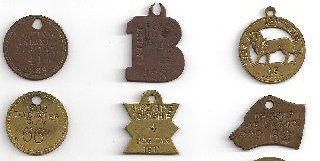
Bob Lyall writes:
We Brits (plus several American stalwarts) have had an annual token congress for some 30+ years now with an auction, a bourse and lots of talks, both short and not so short, but to the best of my memory, never has a talk ever broached the subject of dog licence discs. This may well be because dogs have not been subject to licensing for many years in Britain, I seem to recall my mother had to license the 2 dogs she had when I was a boy, 50+ years ago, but never recall seeing any relevant disc, I think she had a paper certificate.
But, in my little book on Malta tokens I include dog license disks and illustrate 4 whilst listing details for some 20 years between 1941 and 1975 - subsequently I have found a few more, one as early as 1924. In the West Indies there were (are?) license discs for dogs in St Kitts and Nevis, Anguilla, the Caymans, Jamaica and I have a rabies inoculation disc from Turks and Caicos and another from Belize (one time British Honduras). I've never searched them out particularly, so there are probably lots to be found.
In addition, there were license discs for the likes of porters in St Kitts and shoe blacks and ferrymen in Malta. None of these themes have ever, to my knowledge, been a part of paranumismatic interests, but in contrast, in various African countries and in New Guinea (Pacific island north of Australia) hut tax tokens were an annual "thing" in the first 30 years of the 20th century, Rhodesian ones are probably the commonest and these are catalogued by Hern with Southern African tokens (all be it at values I think are extraordinary, but who am I to adjudge South African token values). New Guinea ones were catalogued by Bill Mira together with coins and tokens.
So, beauty is in the eye of the beholder surely - if you want to include tax / license discs with your token collection, then just do it! I sit on the fence and have a few but not a comprehensive collection so you can sling mud at me from both directions!!
To read the earlier E-Sylum article, see: ARE DOG LICENSE TAGS EXONUMIA? (www.coinbooks.org/esylum_v15n02a09.html)
QUERY: HUNT BOOKS ON WWII PHILIPPINE EMERGENCY CURRENCY
I am presently performing research on the various counterstamps which appear on Philippine guerrilla notes in general, and on the 1941 One Peso Cebu note in particular. I am attempting to compile a detailed list of the municipalities which used counterstamps. With respect to the 1941 One Peso Cebu note, I am also compiling a list of the dates the counterstamps were used and a geographical distribution.
An author who wrote about Philippine guerrilla notes and lightly touched upon the counterstamps is John M. Hunt. He self-published in the Philippines a number of books/monographs on Philippine guerrilla notes, including "World War II Emergency Currency for Mountain Province" and "Caveat Emptor." Does anybody know of any other books/monographs he published and, if so, where they may be obtained?
BRONX COIN CLUB MEDALS WANTED
Contact William Marquis at WMarq69070@aol.com with
description and price. I need the 1933, 1938, 1950 and 1994 medals.
QUIZ ANSWERS: WHO ARE THESE 1930S NUMISMATISTS?
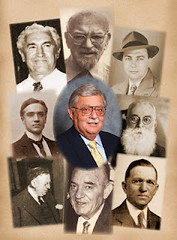 Last week I asked if anyone could identify the eight numismatists pictured here with Harvey Stack (center). The top left is #1, and we count clockwise through #8.
Last week I asked if anyone could identify the eight numismatists pictured here with Harvey Stack (center). The top left is #1, and we count clockwise through #8.
Greg Adams writes:
I identified these:
1. Abe Kosoff,
3. John J Ford Jr,
5. B. Max Mehl,
7. Raymond Wyatt,
8. Thomas L. Elder
And decided to stop…
Pete Smith writes:
I give up! After hours of research, I still cannot identify all the numismatists with Harvey Stack. One problem - I believe these pictures are from different eras so they do not show how these numismatists looked in the thirties. If I am correct, the photos may have been taken as much as fifty years apart.
These are the ones I can identify:
1. Abe Kosoff;
2. Unknown;
3. John J. Ford;
4. Henry Chapman;
5. B. Max Mehl;
6. Norman Shultz;
7. Wayte Raymond and
8. Thomas Elder.
I operated on the assumption that everyone pictured was also mentioned in the article. Somewhat by elimination, I thought the unidentified numismatist might be William Rabin, but I could not find another photo for confirmation.
Originally I thought number three was Hans Schulman, but he was not mentioned in the article. I now believe it is Ford, looking much younger than the man I got to know.
David Gladfelter writes:
Using John Adams’s United States Numismatic Literature books as a crib sheet (you didn’t say we couldn’t) I would make the following identifications:
1 – Abe Kosoff,
2 – Joseph Stack
3 – return to him later
4 – Henry Chapman
5 – B. Max Mehl
6 – Morton Stack
7 – Wayte Raymond
8 – Thomas Elder
The hombre in #3 is a dead ringer for Humphrey Bogart, but I can’t come up with a numismatic connection to him. What is it?
Even Harvey Stack couldn't get them all. He identified these:
1. Abe Kosoff
2. Joseph B. Stack, my uncle, and father of Ben & Norman
all deceased.
3. John J. Ford, Jr.
4 ?
5. B. Max Mehl
6. Morton M. Stack, my father and Larry's grandfather.
7. One of the Guttag Bros, (possibly Julius)
8. Thomas L. Elder.
So the consensus answer seems to be:
1. Abe Kosoff
2. Joseph B. Stack
3. John J. Ford
4. Henry Chapman
5. B. Max Mehl
6. Morton M. Stack
7. Wayte Raymond and
8. Thomas Elder
Thanks for playing, everyone - this was fun!
To read the earlier E-Sylum article, see: QUICK QUIZ: WHO ARE THESE 1930S NUMISMATISTS? (www.coinbooks.org/esylum_v15n11a16.html)
HARVEY STACK REMEMBERS: THE STACK'S STOREFRONT LOCATIONS
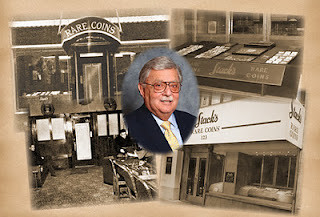
In 1933, when brothers Morton and Joseph B. Stack decided to open in what was then midtown New York, 6th Avenue and 22nd Street, they created a plan to enhance the ambiance of a coin shop.
The relatively few dealers then in New York City had offices upstairs in office buildings, requiring an elevator ride or a walk up a few flights of steps and stand-up jewelers-type show cases to view. The Stacks decided that this was not the way to greet clients, so they decided on a street level location, in a well-traveled area of the city, to make visitors feel welcome and comfortable.
The major innovation were showcases, served by comfortable chairs, where collectors could sit, look at and study coins or other items and chat with those behind the counter about numismatics. The walls were brown oak paneling, the furniture was of similar wood, and the decorations were of numismatic displays—currency, coin plaques, decorative medals, bookshelves and numismatic related documents. It was like a small museum to attract visitors who would feel the warmth of the Shop. Near the front entrance was a couch for clients to wait if the counters were busy.
The family, over the next decade employed or had working for them on a contract basis, some of the greatest numismatists in the New York area, including Hans Holzer, Edward May, James C. Risk, Henry Grunthal, Fred Knobloch, and John J. Ford, Jr., to mention but a few. These numismatists were available, along with members of the Stack family, to help customers, catalog items, and develop friendships that prevailed for decades.
Even collectors who visited contributed to the strength of Stack's cataloging. Such great numismatists as Howard Newcomb, William Sheldon, Harold Bareford, Joseph Spray, Ray Gallo, Oscar Schilkee, Otto Skia, Martin Kortjohn and others too numerous to mention, became part of the team as the firm developed. Great collectors of the period, such as Col. E.H.R. Green, James A. Stack, Clifford Weihman and many others, sat with the staff, discussed coins and developed their collections.
The Shop was considered by all these people a 'CLUB HOUSE ', a place to gather, meet other collectors and the extensive staff of Stack’s, discuss, collect and learn about numismatics. Being on the street level provided the perfect place for gatherings, and through the gracious reception, warm ambiance and friendships made, the firm of Stacks continued to grow.
As the economic environment in the city changed, with great and important shops opening, Stacks followed and changed its location several times in the years before 1953, when the present and long standing shop was opened at 123 West 57th Street—a main street for art and fine shops. From our 6th Avenue location we moved to 32 W. 46th Street, a few steps from 5th Avenue, and after World War II we were given the opportunity to purchase a building, even closer to Fifth Avenue, at 12 West 46th Street. We stayed there, until the neighborhood started to change (with discount stores opening up and down the street) to our present location where we have remained for almost 60 years.
David Gladfelter adds:
Harvey Stack writes: “Now, Stack’s Bowers is refurbishing and redecorating the store (or shop to some) [at 123 W. 57th St.]. The walls will be redone, the counters refinished, the carpet replaced, the lighting changed, the entrance enhanced, the show windows re-designed, the air conditioning re-done— all things that will make the store continue to be inviting and attractive to visitors.”
Now is the time, then, for those who haven’t been inside the old place to go see it. It’s changed very little in the 45+ years since I’ve been going there. In the 60s when I was looking for a scarce 1815/12 half dollar and planning to visit the World’s Fair in New York, David Derzon, a Milwaukee coin dealer, advised going to Stack’s – “they can show you that coin in all grades from G to Unc.” Hard to believe? Checked it out. Norman Stack himself took my request, bringing out an array of coins in all grades from which to choose (I liked the VF and still have it).
I suppose that some would call the store’s décor dated, but understand, I am too. If you do go I can recommend a French restaurant within walking distance that Anthony Bourdain says hasn’t changed since 1937.
To read the complete article, see: Remember When: The Value Of The Stack’s Bowers Coin Store (stacksbowers.com/Blogs/remember-when-value-of-stacks-bowers.html)
QUERY: EAGLE ENGRAVING & STAMPING INFORMATION SOUGHT
Ralf Boepple writes:
I found this in a German coin and medal auction. I have no idea of the background of this item, but in my experience as a long time reader of the E-Sylum, I figured it could be of interest to the audience.

To read the original lot description, see: Lot: 81 (www.sixbid.com/nav.php?p=viewlot&sid=556&lot=81)
To read the complete article, see:
EAGLE ENGRAVING AND STAMPING CO. PROMOTIONAL MEDAL
(www.numismaticamericana.com/sales-repository/eagle
-engraving-and-stamping-co-promotional-medal/)
Obverse Legend: COMPLIMENTS OF EAGLE ENGRAVING and STAMPING CO./ OFFICE ROBT. STOLL 19 JOHN ST. NEW YORK; on lower margin, in small caps., D.BRENNER FECIT N.Y. Obverse Type: Cavalier standing before panoply of arms atop column; below, spread eagle l., hd. r.
Reverse Legend: MANUFACTURERS OF/ COINS,/ MEDALS,/ BADGES, ETC./ ALL KINDS OF STAMPING IN/ GOLD, SILVER, BRONZE, BRASS, ETC./ INGENERAL FOR THE TRADE/ PRESS and DROP HAMMER WORK/ A SPECIALTY/ 92 FULTON ST. and/ 132 WILLIAM ST./ NEW YORK./ ESTIMATES FURNISHED WITH OR WITHOUT DIES
Descriptive Information
Object Type: Medal
Axis: 12
Date on Object: nd
Material: Al
Measurements: 44.8 mm
Department: Medal
So this is an early Victor David Brenner medal. I found another unillustrated listing from the Stack's Philadelphia Americana Sale - 9/30/2010, Lot 5668. The medal sold for $690.00.
A COUNTERFEIT SUSAN B. ANTHONY DOLLAR
An E-Sylum reader writes:
Here's a counterfeit Susan B. Anthony dollar that had come in a batch of dollar coins from South America for redemption. There's no way to know if it came from the Colombia operation mentioned a couple E-Sylums back, but it might well have.
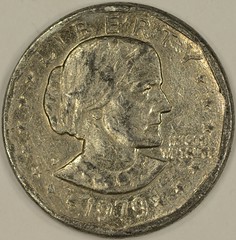


To read the earlier E-Sylum article, see: ARTICLE EXPLORES THREAT OF DOLLAR COIN COUNTERFEITING (www.coinbooks.org/esylum_v15n10a16.html)
THE BOOK BAZARRE
WAYNE'S NOT-SO-NUMISMATIC DIARY: MARCH 18, 2012
My numismatic endeavors have been limited lately. Last week I traveled for business to Honolulu and during the long plane rides I caught up on some reading. The first was a quick read - David Ganz' new book, The Essential Guide to Investing in Precious Metals. Requiring much more time was a manuscript by Roger Burdette. Both were enjoyable and I learned a number of things.
 I showed some of my colleagues a holed Hawaiian quarter I keep on my keychain. I forget where I got it - it may have been through John Burns many years ago. Speaking of Hawaii, there was a story out this week about a collector who noticed "extra islands" on Hawaii state quarters - probably created by die pits.
I showed some of my colleagues a holed Hawaiian quarter I keep on my keychain. I forget where I got it - it may have been through John Burns many years ago. Speaking of Hawaii, there was a story out this week about a collector who noticed "extra islands" on Hawaii state quarters - probably created by die pits.
A Hawaii coin collector says there may be some Hawaii commemorative quarters out there worth keeping.
Joseph Au-Franz says he's found about ten of Hawaii's commemorative quarters coins with two extra islands on them.
Au-Franz does not know how many quarters were made with the extra islands or how much each coin is worth.
To read the complete article, see:
Hawaii coin collector finds errors on commemorative quarters
(www.khon2.com/news/local/story/Hawaii-coin
-collector-finds-errors-on/1rgBczmgUEyRVWY6LK_X-w.cspx)
Ordinarily, this week's diary would be filled with my tales from Tuesday's meeting of Nummis Nova, but I ended up out of town that day too, this time for a family funeral. But I did the next best thing and asked the attendees to pass along reports of their own, Here they are.
Dave Schenkman writes:
I brought a variety of items to show. The theme was something to do with beasts, so one of the items I brought was a 1695 thaler of Leopold I, the Hogmouth. I also brought a French Napoleon III satirical jeton, and a 42.5mm 14k gold medal marked Tiffany & Co. I wrote a column for The Numismatist about it a few years ago.
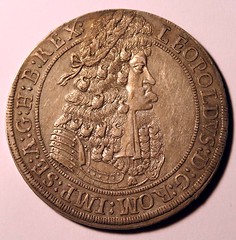

Numismatic Bestiary: Leopold I, the Hogmouth (Image courtesy David Schenkman)
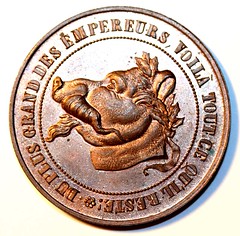

Napoleon satirical jeton (Image courtesy David Schenkman)
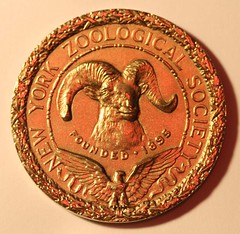
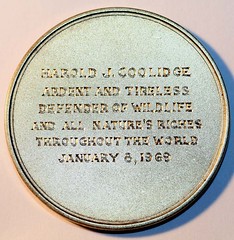
Numismatic Bestiary: New York zoological Society (Image courtesy David Schenkman)
Dave adds:
I also brought a rare ad note from Baltimore with the 1889 baseball team on it.
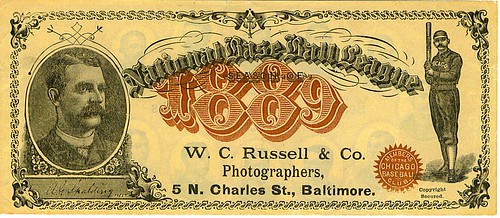

Tom Kays writes:
The best object brought for show and tell was Dave's 1889 National League Baseball advertising note featuring steel engravings of the championship team. George Cash visiting from Richmond had never seen one and said it was remarkable.
Mike Packard brought a Chinese box dollar, Joe Levine brought a VDB plaque of the Gettysburg Address with an embedded 1916 cent. Also seen were a stack of military payment certificates series 591, a Sheldon 221 large cent of 1801, a very high grade Massachusetts cent of 1787, and George Cash brought an original Virginia token book of Dave's found in unbound reams at the printers after 35 years abandonment. Placed in three ring binders they sell for $36 to benefit the VNA.
I brought coin beasts per our theme for March including a 1599 Zeeland sea lion Thaler known here in America as a dog paddle dollar with rampant lion of that Low Country bobbing above the waves seemingly pleading for someone to build a dyke and a 1623 St Galen Thaler with rampant bear of the dancing Swiss variety.
I showed a website that offers one year of the Alexandria Gazette from July 1813 to July 1814 in a bound folio volume in the hopes that Chris Neuzil might buy it and share it with us as a future show and tell.
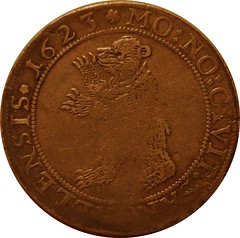
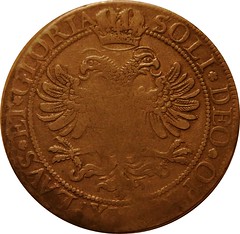
Numismatic Bestiary: Bear (Image courtesy Tom Kays)
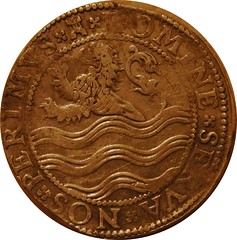
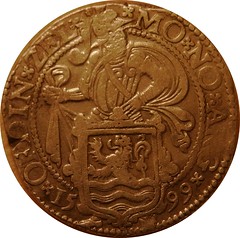
Numismatic Bestiary: Sea Lion (Image courtesy Tom Kays)
Tom adds:
A guest brought some nice ancients with various mythological beasts including a nice stater of Carthage with Pegasus. The evening really got out of hand when I gave Gene Brandenburg a signed blank check for coins sight unseen that he thought he would not show me being they had errors and might be bogus and that we were all rather well along with refreshments and conviviality unbecoming the harsh reality of the coin trade but that is another story. What happens at Nummis Nova stays at Nummis Nova.
Eric Schena brought a banknote with an eagle motif from the early 1800s that had a cartoon device whereby the eagle speaks out the side of his beak. Does anyone know of other such cartoon techniques such as thought balloons or emoticons used on early federal or colonial notes? Just how early were such cartoon artifices used and can E-Sylum readers provide more examples of cartoon devices on banknotes and coins that depict actions of the characters? I can think of some already.
Eric hosts next and the theme for April I understand will be death and taxes, two sure things on which we may count and which I invite the readership to suggest what one numismatic object best brings to mind both concepts?
Eric Schena writes:
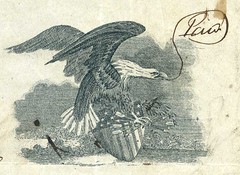 Here's some more background on what I brought. I brought a $1000 bill of exchange from an iron furnace in Botetourt Co., VA, from 1849. Since the eagle illustration with the cartoon balloon was the highlight, here's a photo of the bill plus a detail with the eagle saying he paid the bill of exchange. I thought it was neat that someone from 1849 had a sense of humor like that.
Here's some more background on what I brought. I brought a $1000 bill of exchange from an iron furnace in Botetourt Co., VA, from 1849. Since the eagle illustration with the cartoon balloon was the highlight, here's a photo of the bill plus a detail with the eagle saying he paid the bill of exchange. I thought it was neat that someone from 1849 had a sense of humor like that.

Many thanks for the assistance this week, and the great images. I missed some great stuff!
NOTES FROM E-SYLUM READERS: MARCH 18, 2012
The Mysterious Amulet's 1942 Copyright
Ray Williams writes:
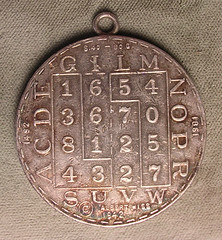 On the identification of the mysterious medal, I can't help. But I see that there is a 1942 copyright and a name... has anyone looked to see if there was an explanation in the copyright, if it was actually filed?
On the identification of the mysterious medal, I can't help. But I see that there is a 1942 copyright and a name... has anyone looked to see if there was an explanation in the copyright, if it was actually filed?
To read the earlier E-Sylum article, see:
QUERY: A SILVER AMULET
(www.coinbooks.org/esylum_v15n11a12.html)
More on Counterfeit Indian Banknotes
Joe Boling writes:
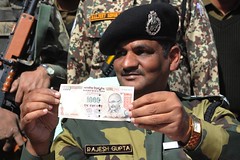 The illustration in the article about counterfeit Indian notes shows a note that I have not yet seen as a counterfeit. However, I have seen notes in series before this one that appear to be printed on stolen genuine paper (but are not) - the security features mentioned in the article are indeed there. But the genuine notes are intaglio, and so far the counterfeits have been lithographed with an "optically-variable ink" feature that doesn't vary. Nevertheless, the notes are extremely deceptive, because of the presence of the watermarks, the embedded security thread, an excellent artificial latent image, and almost 100% replication of the ultraviolet and infra-red features.
The illustration in the article about counterfeit Indian notes shows a note that I have not yet seen as a counterfeit. However, I have seen notes in series before this one that appear to be printed on stolen genuine paper (but are not) - the security features mentioned in the article are indeed there. But the genuine notes are intaglio, and so far the counterfeits have been lithographed with an "optically-variable ink" feature that doesn't vary. Nevertheless, the notes are extremely deceptive, because of the presence of the watermarks, the embedded security thread, an excellent artificial latent image, and almost 100% replication of the ultraviolet and infra-red features.
To read the earlier E-Sylum article, see: PAKISTANI GROUPS COUNTERFEITING INDIAN BANKNOTES (www.coinbooks.org/esylum_v15n11a19.html)
About the Book Bazarre
Regarding THE BOOK BAZARRE, Ken Spindler of
San Diego writes:
Perhaps this was intended as a little joke, but it seems more likely it wasn't, since it is not only the wrong word, but misspelled at that ("bizarre" misspelled "bazarre" where "bazaar" has the intended meaning):
Ken also noticed a typo in the Gadoury book review; we'll fix our archive. He writes:
 The listing of the new Gadoury edition book on French coins from 1610-1792 thrice, including in the title, states 1712 vs. 1792
The listing of the new Gadoury edition book on French coins from 1610-1792 thrice, including in the title, states 1712 vs. 1792
To read the earlier E-Sylum article, see:
BOOK REVIEW: LES MONNAIES ROYALES FRANÇAISES 1610-1792, 4TH ED.
(www.coinbooks.org/esylum_v15n11a04.html)
More on the Book on Spintrae
George Kolbe writes:
 I thought that some of the more scholarly numismatic researchers of the Big E might be interested in details of the work on spintrae:
I thought that some of the more scholarly numismatic researchers of the Big E might be interested in details of the work on spintrae:
Simonetta, Bono, and Renzo Riva. LE TESSERE EROTICHE ROMANE (SPINTRIAE), QUANDO ED A CHE SCOPO SONO STATE CONIATE. Lugano, 1981. 8vo, original printed boards. 44 pages, including 7 plates. French, German, and English summaries.
Once difficult to sell, copies are now in demand by inquiring scholars and are bringing well over one hundred dollars.
David Fanning's comment following the last copy sold by Kolbe & Fanning is instructive: "A good book to show visitors who find your hobbies dull."
To read the earlier E-Sylum article, see: BOOK ON SPINTRIAE: LE TESSERE EROTICHE ROMANE (www.coinbooks.org/esylum_v15n11a06.html)
South Carolina Forestry Commission Challenge Coins
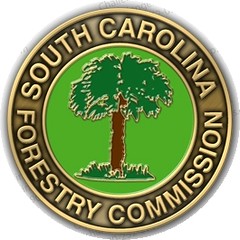 An E-Sylum reader forwarded this story about a challenge coin from South Carolina.
An E-Sylum reader forwarded this story about a challenge coin from South Carolina.
To read the complete article, see:
Military-style challenge coin awarded by forest industry
(www.wmbfnews.com/story/17146370/military-style
-challenge-coin-awarded-by-forest-industry)
The Joy of Books
Michael Sullivan writes:
We have many "Creative Minds" in our numismatic bibliomania circle. I thought our fellow E-Sylum readers may enjoy this most creative video forwarded to me by Gabrielle Fox whose bookbinding and preservation efforts have been critical to my collection development. My daughters said "the books are dancing like us." Enjoy.
To view the video, see: The Joy of Books (www.youtube.com/watch?v=SKVcQnyEIT8)
MORE ON MATTHEW HINCMAN'S TOKENS
Matthew Hincman writes:
It's been a while since you posted about my project. I am still dropping the tokens in the streets! I also minted 50 fine silver coins. I have been selling them for $40 each, with a copper coin included.
From the earlier E-Sylum item:
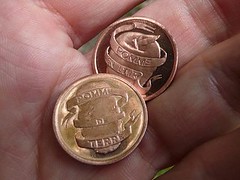 Matthew Hinçman is what some people call a guerilla artist. Guerilla Art, sometimes called Street Art, is unsanctioned art that is developed and displayed in public places. Guerilla art is more than graffiti. It is art designed to surprise and make the public think and sometimes participate.
Matthew Hinçman is what some people call a guerilla artist. Guerilla Art, sometimes called Street Art, is unsanctioned art that is developed and displayed in public places. Guerilla art is more than graffiti. It is art designed to surprise and make the public think and sometimes participate.
One of Hinçman's newest projects is the creation of Pomme de Terre (French for "Potato") and Pomme en l'Air ("Apple in the Air") tokens. Hinçman describes them as "loosely based on mid-19th century Hard Times Tokens."
I asked Matthew for some more details. He writes:
I made the sculptural reliefs in the basins myself, and BEX did the engraving of the dies. They had also done another project for me: Calafia Ruins coins based on the 1797 British Cartwheel Penny.
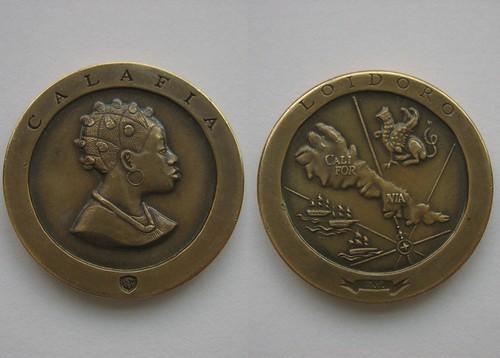
From the Calafia Ruins web page:
Calafia Ruins, 2002
Stolper Residence, La Jolla, California
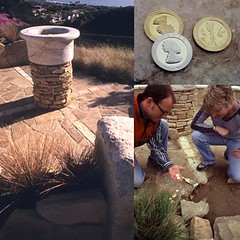 For this installation, I minted my first coins, which then inspired an architectural folly at the edge of the landscape designed by Andy Spurlock. Calafia is the fictitious Queen of the fictitious "Island of California" from the novel Sergas de Esplandian of 1510, written by Garcia Ordoñez de Montalvo. It seems that Cortez had read this "worthless romance" and named the peninsula we now know as Baja California after the fictitious island populated by an amazonian race of women led by the brave warrior Queen Calafia.
For this installation, I minted my first coins, which then inspired an architectural folly at the edge of the landscape designed by Andy Spurlock. Calafia is the fictitious Queen of the fictitious "Island of California" from the novel Sergas de Esplandian of 1510, written by Garcia Ordoñez de Montalvo. It seems that Cortez had read this "worthless romance" and named the peninsula we now know as Baja California after the fictitious island populated by an amazonian race of women led by the brave warrior Queen Calafia.
The obverse of the coin depicts the Queen in profile, modeled after fellow graduate student and theatre major Marsha Stephanie Blake. The reverse of the coin has a small armada of ships, a griffin, which the women of California used in their wars against men, and an actual map of the State of California from the late 17th Century depicting it as an island. There are many famous maps from the 16th Century up to the 18th Century that clearly - yet erroneously - show California as an island. The story even told of the only metal the women had to work with was gold.
To visit the Calafia Ruins web page, see: http://www.flickr.com/photos/hincman/379952414/in/set-72157594518073023
For more information on BEX Engraving, see: www.bexengraving.com
To order the "Hard Times" coins, see: sites.google.com/site/matthewhincmanartist/public-art/21st-Century-hard-times-token .
To read the earlier E-Sylum article, see: COINS FOR HARD TIMES: ARTIST MAKES HIS OWN MONEY (www.coinbooks.org/esylum_v12n41a19.html)
QUIZ ANSWER: MANSHIP'S KULTUR IN BELGIUM MEDAL
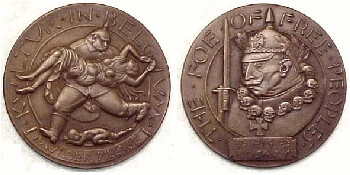
Richard Jewell writes:
The medal you asked to be identified is Paul Manship's infamous "Kultur in Belgium" 1918, produced by Medallic Art Company. It is bronze, 66.2mm and basically it was Manship's response to the many satirical WWI medals of German medalist Karl Goetz.
The obverse has a bust of the Kaiser with a necklace of skulls with a rifle with bayonet in front of him. The legend "THE FOE OF FREE PEOPLES" and in the cartouche "HIS ROSARY".
The reverse depicts a German soldier abducting a helpless Belgian woman with her child on the ground beneath her. Legend :"KULTUR IN BELGIUM" below that "MURDER PILLAGE"
Edwin Murtha's book on Paul Manship is an excellent source for the majority of Manship's sculptures and medals.
Joe Levine forwarded this description:
MANSHIP'S KULTUR IN BELGIUM MEDAL, 1918. Murtha 103; Baxter 365. 66.2mm. Bronze. Paul Manship, Sc. (MACO).. The obverse bears a bust of the Kaiser, who wears a necklace of skulls from which is suspended an iron cross. The surrounding legend reads: THE FOE OF FREE PEOPLES. HIS ROSARY. On the reverse, a German soldier is abducting a helpless woman while her child lies on the ground. KULTUR IN BELGIUM - MURDER PILLAGE.
A grotesque medal which Baxter states was the Amrican answer to the German sculptor Karl Goetz/s satirical war medals. The June, 1918 issue of the American Magazine of Arts reported, “In some of the shop windows on Fifth Avenue, New York, is now to be seen a bronze medal designed and executed by Paul Manship representing the outrages perpetrated by the German army upon women and children in invaded territory, particularly in Belgium. This is offered for sale at $10.00 a piece and puts into permanent form those things which if possible should not be remembered, but if remembered not visualized.”
To read the earlier E-Sylum article, see: FEATURED WEB PAGE: LE MONETE SATIRICHE (www.coinbooks.org/esylum_v15n11a24.html)
THE BOOK BAZARRE
CARPATHIA MEDALS FOR TITANIC RESCUES OFFERED
 Charles Miller Ltd’s auction and sale is open to all and is a unique opportunity to see and buy some of the rare, curious and historic items that will be coming under the hammer next month in London.
Charles Miller Ltd’s auction and sale is open to all and is a unique opportunity to see and buy some of the rare, curious and historic items that will be coming under the hammer next month in London.
The forthcoming sale includes fascinating items relating to Titanic, Nelson, and Shackleton.
Two extremely rare R.M.S Carpathia Medals – one in bronze and one in silver - awarded for the rescue of the survivors of the Titanic are estimated to fetch £4,000-6,000 and £3,000-5,000 respectively when offered for auction in London next month. Inscribed ‘Presented to the Captain, Officers & Crew of R.M.S Carpathia, in recognition of gallant & heroic services from the survivors of the S.S Titanic, April 15th, 1912’. The bronze one is engraved ‘J.J.K Q.M’ – making it even more rare. J.J.K refers to J.J Kirkpatrick – who was known to his crew members as Benjamin and was born in Liverpool. He was just 21 years when made a Quarter Master on the Carpathia and it is believed that he was the man ’at the wheel’ on the fateful night of the sinking and under the orders of Captain Rostron, steered the “gallant little Carpathia” through random ice-flows to reach the disaster scene. It is also recorded that Carpathia’s carpenter, David Eaton, pried the nameplate off Titanic’s lifeboat no.4 and subsequently gave it to Kirkpatrick as a memento.
To read the complete article, see: Medals given to the Titanic rescuers plus document signed by Nelson to be auctioned by Charles Miller (www.artdaily.org/index.asp?int_sec=2&int_new=54217)
MORE ON BRONX COIN CLUB MEDALS
Pete Smith forwarded these images:
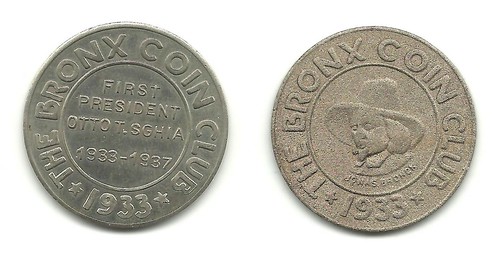
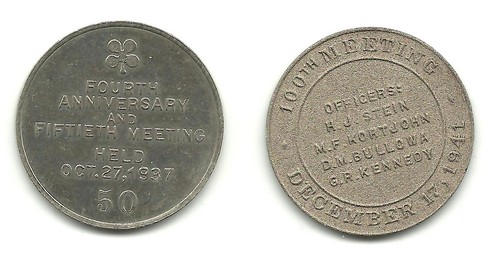
David Alexander writes:
Regarding medals of the Bronx Coin Club, I have encountered the following items over the years. Two of them are listed in "A Century of Civility: the Centennial History of the New York Numismatic Club, 1909/09 - 2008/09" by John M. Kleeberg and David T. Alexander. I am sure others exist. The values attached are "guesstimates" made a few years ago. A personal note: I knew Otto T. Sghia quite well, as he was a founder of the old Miami Coin Club in Florida, to which my late brother John and I belonged in the early 1950's. Sghia (we laterlearned) had been NYNC president in 1942-43.
BRONX COIN CLUB
Bronx Coin Club 50th Meeting Medal, 1937. Copper-nickel, 32mm. Tall letter legend THE BRONX COIN CLUB *1933* at center FIRST/ PRESIDENT/ OTTO T. SGHIA/ 1933-1937. Rev Four-leaf clover, FOURTH/ ANNIVERSARY/ AND/ FIFTIETH MEETING/ HELD/ OCT. 27, 1937/ §. Sghia was later President of NYNC, 1948 a founder of the Miami Coin Club and FUN in 1955. About Uncirculated. ($35-55)
Bronx Coin Club 100th Meeting Medal, 1941. Copper-nickel, 32.3mm. Obv Bust of Jonas Bronck, club legend, 1933. Rev Legend, Dec. 17, 1941. Circle, OFFICERS:/ H.J. STEIN/ M.F. KORTJOHN/ D.M. BULLOWA/ G.R. KENNEDY. (All of NYNC at one time). Lacquered. Uncirculated. ($25-35) Harry Stein was a noted savant and writer in Numismatic Review… focus of anti-Semitic allegations after his aborted attempt to run for NYNC President in 1945.
Bronx Coin Club 15th Anniversary Medal, 1948. Brass, 32.3mm. Obv As last. Rev Club name, founding date 1933. Circle encloses commemorative inscription Oct. 27, 1948. Coin finish. Uncirculated. ($25-35)
Bronx Coin Club 200th Meeting Medal, 1950. Copper cast 44.8mm. Obv Alexander the Great head r., THE BRONX COIN CLUB, 1933. Rev 200TH/ MEETING/ APR. 26, 1950/ *. Coppery red. Uncirculated. ($50-75)
To read the earlier E-Sylum article, see: QUERY: BRONX COIN CLUB MEDAL INFORMATION SOUGHT (www.coinbooks.org/esylum_v15n11a20.html)
ON BRASS, BRONZE, AND GOLDENE
Last week I published a submission from Dick Johnson containing this paragraph:
All of these copper alloys have been used for coins under a variety of terms for the various compositions. These include French bronze, tombac, Dutch metal, Mannheim gold, copper-nickel, and ultimately oroide or goldmine. The latter is at 33% zinc content with an obvious brass-gold color.
Dick writes:
My spellchecker did this to my text -- Sorry! The correct word should have been goldene -- which can also be spelled goldine. (Osborne Coinage spelled it this way, they struck a lot of tokens and medals in this composition.) It is a brass composition often confused for bronze gilt, but there is no gold in goldene.
Bob Neale writes:
I don't wish to be argumentative, but I would like to note this in regard to the learned Dick Johnson's write-up about the composition of brass vs bronze. Most people, especially chemists, consider bronze to be a mixture of copper with tin (and sometimes other things), but not with zinc. Brass is copper with zinc (and in my recollection, often some tin as well). My point is that DJ's comment that "If the zinc is less than 10% it (the copper alloy) is bronze." may be misleading, as this implies that bronze can contain a significant percentage of zinc. (But maybe it can among coinage metallurgists.)
Paul Schultz writes:
I read the brass & bronze definitions in last week’s E-Sylum, and thought I might clarify it from a metallurgist’s point of view.
The problem comes about in the origin of the names, from tradition dating back hundreds of years for some specific alloys, vs. modern definitions for general groups. The modern metallurgical definitions I was taught in my courses for a Master's degree in metallurgy reveal a confusing difference between alloy groups and specific alloys.
For the general categories, the definition of a brass is copper alloyed with less than 40% zinc, and no other elements. Copper with over 40% zinc is Muntz metal. Copper alloyed with anything other than zinc, (especially tin, but also aluminum, nickel, etc, and it may also include zinc along with these other elements) is considered a bronze alloy. An aluminum bronze is copper with aluminum plus possibly other elements, nickel bronze is copper with nickel plus possibly other elements, etc.
The confusing problem is the overlapping traditional naming for the very specific alloys, which go back hundreds of years, and which are not fully consistent with the above modern system. “Commercial Bronze”, composed of 90 copper and 10 zinc, is really a brass alloy by modern definition. “Aluminum brass”, at 76 copper, 22 zinc, and 2 aluminum, is really in the bronze series.
The situation creates more confusion than it alleviates. Specifically for coinage, I believe that most of the copper zinc alloys that are used have a more golden color, and the copper tin alloys have a lighter color. For coinage, it may be more practical to use the modern category definitions which are more consistent with the colors we see in coinage, and ignore the specific traditional names like “Commercial Bronze”. Reference for most of the above is “Physical Metallurgy for Engineers”, Donald S Clark and Wilbur R Varney, Van Nostrand 1962, pp 392-393.
To read the earlier E-Sylum article, see: NUMISMATIC VOCABULARY: BRONZE VS BRASS (www.coinbooks.org/esylum_v15n11a10.html)
MORE ON HANK SPANGENBERGER
Dave Alexander writes:
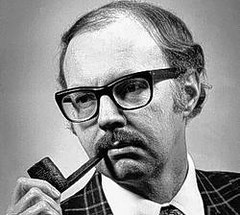 The late, decidedly lamented Hank Spangenberger was also honored by Medal Collectors of America with the Carl W.A. Carlson Award for his truly pioneering role in spearheading the renewal of interest in historical U.S. medals. His column in "Numismatic Scrapbook" should always be remembered for its explorations of Presidential Inaugural Medals, Medals of the Centennial of Independence and, of course, those pesky wooden exposition medals that thoroughly confused modern collectors by the late 1960's. He will be missed.
The late, decidedly lamented Hank Spangenberger was also honored by Medal Collectors of America with the Carl W.A. Carlson Award for his truly pioneering role in spearheading the renewal of interest in historical U.S. medals. His column in "Numismatic Scrapbook" should always be remembered for its explorations of Presidential Inaugural Medals, Medals of the Centennial of Independence and, of course, those pesky wooden exposition medals that thoroughly confused modern collectors by the late 1960's. He will be missed.
Richard Margolis writes:
Very sad to learn of the passing of Hank Spangenberger, hard on the deaths of Bob Myers and Vinnie Alones. Hank, who I had known since his days at Empire so many years ago, was one of the truly knowledgeable and nice guys in our business.
Dick Johnson writes:
I first met Hank Spangenberger when I moved to Dayton Ohio for my first job out of college in 1964. This was before he married Marsha. And speaking of Marsha, she never really embraced Hank's numismatic activities. I remember a convention when we had side-by-side bourse tables. At the end of the show my wife was assisting me breaking down the display. Marsha was standing around, doing nothing. My wife asked if she would help with some minor chore (perhaps like folding up the table cover). She refused, and went into a long explanation that she wouldn't even lend a hand to help her husband.
Hank was a collector before he was a medal dealer. He was afflicted with a condition that a lot of medal dealers suffer from (myself included). Some of the material medal dealers handle is so rare, so desirable, so spectacular, that we never like to part with it. We would never see the likes again. Coin dealers may have their special interests, but if they sold a pet collection, it could easily be replaced in time. Not so with medals.
I recall an incident in New York City. I met with Hank in his hotel room, bought some Olympic items from him. Then he showed me a group of relic medals. Spectacular items, large items of fantastic relic status. Items I had never seen before, nor since. I offered him a ridiculous high sum for the group.
"No, I think I will keep these," was his response. And I didn't blame him. I don't think I would have sold them if I owned them. As a dealer he was a closet collector. His collection of American Centennial items of 1876 was superb. I believe he sold it intact. Perhaps some E-Sylum reader can remember to whom. Other collections he formed found their way to national auctions.
Great personal friend. Great collector who really delved deeply into a collecting specialty that took his fancy. He knew the subject well. It is understandable he was at one time ANA Historian. I will miss him.
To read the earlier E-Sylum article, see: HANK SPANGENBERGER 1934 - 2012 (www.coinbooks.org/esylum_v15n11a08.html)

MORE ON THE STOLEN LIBYAN COIN HOARD
The treasure was kept mostly in two wooden chests, and locked away in a bank vault: thousands of coins, jewelry and figurines, some around 2,600 years old. For decades it sat in the bank, unattended despite the historical and monetary value. Then, as a popular uprising erupted around the downtown bank last winter, someone entered the vault and made off with the trove.
Now, as Interpol searches for the collection on the illegal antiquities markets, questions are still being raised about the nature of the theft. One thing most seem to agree on: The heist was an inside job.
“I cannot say who did it,” said Ahmed Buzaian, an archaeology professor at Benghazi University, who was part of an outside group that investigated the crime scene. “But they knew exactly what was inside.”
What happened, according to the official story, strikes of Harry Houdini meets Ocean’s Eleven. At some point in late March — only a month after rebels in Benghazi had evicted the forces of Col. Muammar Qaddafi and not long after NATO began airstrikes in support of the rebels — a group of thieves broke into the National Commercial Bank of Benghazi, likely from the adjacent building that housed the secret police and that protesters torched at the beginning of the revolution.
Once inside the bank lobby, said Osama El-Ketaf, head of the bank’s legal office, they drilled directly into the vault through a little more than two feet of steel-reinforced concrete. The hole, he said, was big enough for a very skinny adult or a child. In the vault were a series of safes and chests, and power tools were used to tear the containers apart. Inside were nearly 8,000 gold, silver and bronze coins — along with maybe 300 rings, necklaces, bracelets and medallions and another 40 or so bronze and ivory figurines. All of them were unearthed over the first half of the last century in five Greco-Roman cities in northeastern Libya. Taken during the Italian retreat of its former colony in World War II, the trove was returned in 1961, and placed into the vault.
The vault has been shut off from view. Beside some bank personnel, the only people to have entered the vault after the theft were a few archaeologists. And what they saw made them suspicious. The thieves not only knew exactly where to drill to access the vault. The bank waited nearly two months to inform the antiquities department about the heist.
“When I saw the wooden chests ripped open, I started to feel dizzy,” said Nasser Abduljalil, who in April was appointed head of antiquities at the Greco-Roman city of Cyrene, around 110 miles northeast of Benghazi. “But what surprised me even more was that the bank had removed all of the other deposits beforehand” — while the artifacts remained behind, ripe for the taking.
El-Ketaf said the bank didn’t move the treasure because it didn’t have permission. The local Department of Antiquities office was never asked, and the head office in Tripoli was still under Qaddafi control. El-Ketaf added that the bank conducted its own inquiry and found that no one at the branch was connected.

To read the complete article, see: The Libyan Job: Insiders Used War to Steal Priceless Artifacts (www.wired.com/dangerroom/2012/03/libyan-job/)
SOME SWEDES ADVOCATE ELIMINATING CASH
 Sweden was the first European country to introduce bank notes in 1661. Now it's come farther than most on the path toward getting rid of them.
Sweden was the first European country to introduce bank notes in 1661. Now it's come farther than most on the path toward getting rid of them.
"I can't see why we should be printing bank notes at all anymore," says Bjoern Ulvaeus, former member of 1970's pop group ABBA, and a vocal proponent for a world without cash.
The contours of such a society are starting to take shape in this high-tech nation, frustrating those who prefer coins and bills over digital money.
In most Swedish cities, public buses don't accept cash; tickets are prepaid or purchased with a cell phone text message. A small but growing number of businesses only take cards, and some bank offices – which make money on electronic transactions – have stopped handling cash altogether.
"There are towns where it isn't at all possible anymore to enter a bank and use cash," complains Curt Persson, chairman of Sweden's National Pensioners' Organization.
He says that's a problem for elderly people in rural areas who don't have credit cards or don't know how to use them to withdraw cash.
The decline of cash is noticeable even in houses of worship, like the Carl Gustaf Church in Karlshamn, southern Sweden, where Vicar Johan Tyrberg recently installed a card reader to make it easier for worshippers to make offerings.
"People came up to me several times and said they didn't have cash but would still like to donate money," Tyrberg says.
Bills and coins represent only 3 percent of Sweden's economy, compared to an average of 9 percent in the eurozone and 7 percent in the U.S., according to the Bank for International Settlements, an umbrella organization for the world's central banks.
"Less cash in circulation makes things safer, both for the staff that handle cash, but also of course for the public," says Par Karlsson, a security expert at the organization.
The prevalence of electronic transactions – and the digital trail they generate – also helps explain why Sweden has less of a problem with graft than countries with a stronger cash culture, such as Italy or Greece, says economics professor Friedrich Schneider of the Johannes Kepler University in Austria.
"If people use more cards, they are less involved in shadow economy activities," says Schneider, an expert on underground economies.
To read the complete article, see:
In Sweden, Cash Is King No More
(www.huffingtonpost.com/2012/03/17/sweden-eu-cash
-cashless-money_n_1355510.html)
COUNTERFEITERS TARGET GIRL SCOUTS
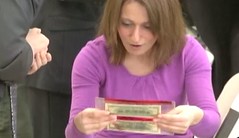 Whether you prefer Do-Si-Dos or Thin Mints, almost everyone loves a Girl Scout cookie, but the annual fundraiser has created a spike in crime across the country this year that has even the Secret Service stepping in.
Whether you prefer Do-Si-Dos or Thin Mints, almost everyone loves a Girl Scout cookie, but the annual fundraiser has created a spike in crime across the country this year that has even the Secret Service stepping in.
At least two troops on opposite sides of the U.S. have received counterfeit money in exchange for boxes of their cookies. Troop 60916 in Tynsborough, Mass., spent Sunday afternoon selling cookies, and took their $258 deposit to the bank when the teller told troop leader Dianna Mines that four of her $20 bills were fake.
But the Massachusetts troop wasn't the only one hit by counterfeiters. Scouts in the Central California South council based in Fresno, Calif., received a fake $100 bill in exchange for cookies, and their council store received two more.
"Sometimes you think $100 isn't a big deal, but, for that little girl selling cookies for hours or the volunteer giving their time, it's a lot," said Cathy Ferguson, CEO of the Girl Scouts of Central California South.
That's when the Secret Service stepped in, thanks to a troop dad who works with the agency. Agents conducted a workshop that taught staff members and troop leaders how to recognize phony money. They were told to look for three key signs: a watermark portrait to the right of the printed president's picture, a security strip on the left imprinted with the letters "USA" and the amount of the bill, and color-shifting numbers that can be detected when the bill is held at an angle in the light.
Ferguson said the money from the cookie sales stays within each individual troop to fund their programs so they are the ones that benefit from the hands-on training.
"It's not like they're taking money from the Girl Scouts of America. That little girl standing there with a smile on her face is the one they're ripping off," Ferguson said.
To read the complete article, see:
After Fake Bills Passed, Girl Scouts Get Schooled By Secret Service
(abcnews.go.com/US/california-girl-scouts-lesson-secret
-service-receiving-counterfeit/story?id=15928039#.T2TykRGPU4Q)
BANK OF ENGLAND HALTS SALE OF BANKNOTE TISSUES
 IT’S not often you get the chance to blow your nose on a £50 note - but the Bank of England failed to see the funny side of novelty banknote tissues sold by a Melton gift store.
IT’S not often you get the chance to blow your nose on a £50 note - but the Bank of England failed to see the funny side of novelty banknote tissues sold by a Melton gift store.
Bright Ideas in Burton Street had been selling the pocket tissues via its online eBay shop but the store was recently informed by eBay that they had to be removed from sale on instruction from the Bank of England.
Joint business owner Sarah Neale said: “It’s just ridiculous. We said in the title that they were novelty bank note tissues and stated they were not real currency.
“It’s obvious that they’re novelty tissues. It’s just so stupid.
“I was told our listing wasn’t against eBay’s policy but they told us they had been instructed by the Bank of England to remove them.
“Surely the Bank of England has better things to do than this.”
She added: “Quite a few of our customers have commented on it. We’ve even had one regular customer who sent us an email asking if he could pay for a little figurine with the paper tissue money!”
The tissues, featuring the designs of £50, £20 and £10 notes on a much smaller scale in size, had also been sold in store costing 99p per pack.
A Bank of England spokesman said: “Under section 18(1) of the Forgery and Counterfeiting Act 1981 it is a criminal offence for any person, without the prior consent in writing of the Bank of England, to reproduce on any substance whatsoever, and whether or not on the correct scale, any Bank of England banknote or any part of a Bank of England banknote.
To read the complete article, see:
Here’s a story not to be sneezed at...
(www.meltontimes.co.uk/news/local/here-s-a-story-not-to
-be-sneezed-at-1-3623984)
BOOKS AS ART: THE BEINECKE RARE BOOK LIBRARY
Joe Boling writes:
Check out Ailsa Prideaux-Mooney's post, for bibliophiles. Ailsa is an acquaintance from my Seattle theater days. She now works in New York as an actor.
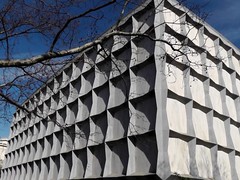 This weekend, I found myself in New Haven, Connecticut; home to Yale University and their famed Beinecke Rare Book & Manuscript Library. How could I resist? I went along not knowing quite what to expect, and was bowled over by this incredible gem of a library. From the outside it is a gleaming, chequered, rectangular building of translucent marble.
This weekend, I found myself in New Haven, Connecticut; home to Yale University and their famed Beinecke Rare Book & Manuscript Library. How could I resist? I went along not knowing quite what to expect, and was bowled over by this incredible gem of a library. From the outside it is a gleaming, chequered, rectangular building of translucent marble.
Walk through the doors, however, and the gleaming facade becomes a distant memory. The marble that shines so brightly from the outside takes on a delicious brownish hue inside the building, transmitting the faintest of light devoid of damaging rays that could harm the delicate pages of the rarest of books.
And there, right in the centre of this dimly glowing building, is a glass-encased tower of stacked book shelves, towering impossibly high above your head, reaching right up to the ceiling.
Shelves and shelves of the most tantalising books, the majority leather-bound, some brightly embossed, some dulled with age, all beautiful.
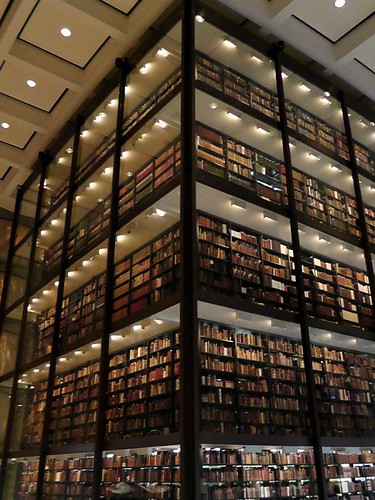
On the upper level, some books were singled out for special attention; the Gutenberg Bible and Audubon’s The Birds of America amongst them. In the eerie half-light, the books almost seemed to be levitating mid-air. It was magical.
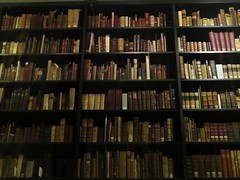 As I was on my way out, I stopped to chat with security, and asked them which lucky people got to snuffle through all those incredible books. They told me, to my delight, that anyone can read the books there, provided you supply a driver’s license, or a passport if you’re from overseas. Their catalogue of books is available online. That service is only available from Monday to Friday, however, so I shall have to return mid-week at some point and crack open a well-worn tome or two.
As I was on my way out, I stopped to chat with security, and asked them which lucky people got to snuffle through all those incredible books. They told me, to my delight, that anyone can read the books there, provided you supply a driver’s license, or a passport if you’re from overseas. Their catalogue of books is available online. That service is only available from Monday to Friday, however, so I shall have to return mid-week at some point and crack open a well-worn tome or two.
To read the complete article, see: Books as art at the Beinecke (http://wheresmybackpack.wordpress.com/2012/03/12/books-as-art-at-the-beinecke/)
BREWSTER KAHLE'S ARK FULL OF BOOKS
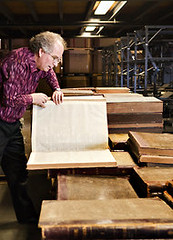 In a wooden warehouse in this industrial suburb, the 20th century is being stored in case of digital disaster.
In a wooden warehouse in this industrial suburb, the 20th century is being stored in case of digital disaster.
Forty-foot shipping containers stacked two by two are stuffed with the most enduring, as well as some of the most forgettable, books of the era. Every week, 20,000 new volumes arrive, many of them donations from libraries and universities thrilled to unload material that has no place in the Internet Age.
Destined for immortality one day last week were “American Indian Policy in the 20th Century,” “All New Crafts for Halloween,” “The Portable Faulkner,” “What to Do When Your Son or Daughter Divorces” and “Temptation’s Kiss,” a romance.
“We want to collect one copy of every book,” said Brewster Kahle, who has spent $3 million to buy and operate this repository situated just north of San Francisco. “You can never tell what is going to paint the portrait of a culture.”
As society embraces all forms of digital entertainment, this latter-day Noah is looking the other way. A Silicon Valley entrepreneur who made his fortune selling a data-mining company to Amazon.com in 1999, Mr. Kahle founded and runs the Internet Archive, a nonprofit organization devoted to preserving Web pages — 150 billion so far — and making texts more widely available.
But even though he started his archiving in the digital realm, he now wants to save physical texts, too.
“We must keep the past even as we’re inventing a new future,” he said. “If the Library of Alexandria had made a copy of every book and sent it to India or China, we’d have the other works of Aristotle, the other plays of Euripides. One copy in one institution is not good enough.”
Mr. Kahle had the idea for the physical archive while working on the Internet Archive, which has digitized two million books. With a deep dedication to traditional printing — one of his sons is named Caslon, after the 18th-century type designer — he abhorred the notion of throwing out a book once it had been scanned. The volume that yielded the digital copy was special.
And perhaps essential. What if, for example, digitization improves and we need to copy the books again?
“Microfilm and microfiche were once a utopian vision of access to all information,” Mr. Kahle noted, “but it turned out we were very glad we kept the books.”

To read the complete article, see:
In a Flood Tide of Digital Data, an Ark Full of Books
(www.nytimes.com/2012/03/04/technology/internet
-archives-repository-collects-thousands-of-books.html)
FEATURED WEB PAGE: BIRTH OR BABY COINS AND SETS
This week's Featured Web Page is about Birth or Baby Coins and Sets from World Mints. Thanks to Coin Update for the link to this March 13 blog post.Since the United States Mint has launched a new “Birth Set” today, I thought it would be interesting to explore some of the birth or baby coins and sets offered by world mints. Whereas the US Mint is a new entrant into this space, other world mints have been producing specially themed legal tender coins or themed packaged sets for years.

world.mintnewsblog.com/2012/03/birth-or-baby-
coins-and-sets-from-world-mints/
